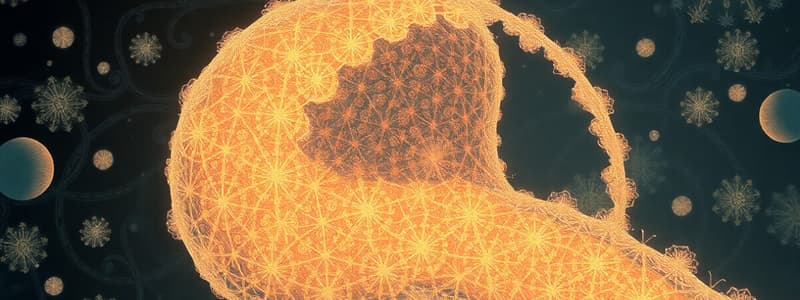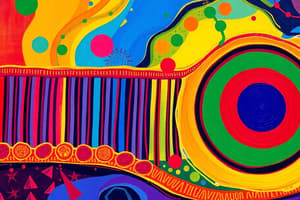Podcast
Questions and Answers
What effect do calcium ions have on sodium channel activation gates?
What effect do calcium ions have on sodium channel activation gates?
- They make it easier for sodium channels to open.
- They stabilize the activation gates, making it harder for them to open. (correct)
- They enhance the excitability of the membrane.
- They have no effect on sodium channel activation.
How does a high extracellular fluid calcium ion concentration affect sodium ion permeability?
How does a high extracellular fluid calcium ion concentration affect sodium ion permeability?
- It fluctuates sodium ion permeability based on other ions present.
- It increases sodium ion permeability.
- It reduces sodium ion permeability. (correct)
- It has no impact on sodium ion permeability.
What is the safety factor in the context of nerve impulses?
What is the safety factor in the context of nerve impulses?
- The ratio of nerve impulse frequency to action potential strength.
- The time taken for a nerve impulse to travel across a synapse.
- The ratio of action potential strength to excitability threshold. (correct)
- The measure of the voltage across the membrane during rest.
What is the primary mechanism of action of local anesthetics on sodium channels?
What is the primary mechanism of action of local anesthetics on sodium channels?
What occurs when the safety factor is reduced below 1.0?
What occurs when the safety factor is reduced below 1.0?
Which type of protein is solely responsible for diffusion?
Which type of protein is solely responsible for diffusion?
What characterizes facilitated diffusion compared to simple diffusion?
What characterizes facilitated diffusion compared to simple diffusion?
How do carrier proteins primarily transport substances?
How do carrier proteins primarily transport substances?
Which process requires moving water molecules through specific channels in the membrane?
Which process requires moving water molecules through specific channels in the membrane?
What distinguishes active transport from passive transport?
What distinguishes active transport from passive transport?
Which of the following describes the motion involved in diffusion?
Which of the following describes the motion involved in diffusion?
Aquaporins are essential for which mechanism of transport?
Aquaporins are essential for which mechanism of transport?
Which term refers to the total concentration of solute particles in a solution?
Which term refers to the total concentration of solute particles in a solution?
What energy source is primarily used by the sodium-potassium pump?
What energy source is primarily used by the sodium-potassium pump?
What is the main function of the sodium-potassium pump?
What is the main function of the sodium-potassium pump?
How many sodium ions does the sodium-potassium pump move outside the cell for each cycle?
How many sodium ions does the sodium-potassium pump move outside the cell for each cycle?
What is the role of the alpha subunit in the sodium-potassium pump?
What is the role of the alpha subunit in the sodium-potassium pump?
What is the concentration ratio of calcium ions inside the cell compared to outside?
What is the concentration ratio of calcium ions inside the cell compared to outside?
What type of transport process does the sodium-potassium pump utilize?
What type of transport process does the sodium-potassium pump utilize?
What happens to the electrical potential inside the membrane as a result of the sodium-potassium pump's activity?
What happens to the electrical potential inside the membrane as a result of the sodium-potassium pump's activity?
Which of the following describes the calcium pump's main function?
Which of the following describes the calcium pump's main function?
Which components are involved in the sodium-potassium pump binding process?
Which components are involved in the sodium-potassium pump binding process?
Which organelles are examples of where calcium pumps operate?
Which organelles are examples of where calcium pumps operate?
What happens when the inside of the cell membrane becomes positively charged?
What happens when the inside of the cell membrane becomes positively charged?
What initiates the opening or closing of a gated channel?
What initiates the opening or closing of a gated channel?
How wide is a typical sodium channel?
How wide is a typical sodium channel?
What role do amino acids play in sodium channels?
What role do amino acids play in sodium channels?
At what condition do gated channels typically exhibit variability in their state?
At what condition do gated channels typically exhibit variability in their state?
What is the primary function of ligand-gated channels?
What is the primary function of ligand-gated channels?
Which of the following is an example of a ligand that can affect gated channels?
Which of the following is an example of a ligand that can affect gated channels?
What occurs during the closed state of a sodium channel?
What occurs during the closed state of a sodium channel?
What characterizes the open state of a gated channel?
What characterizes the open state of a gated channel?
What is a key feature of the potassium gates in relation to membrane potential?
What is a key feature of the potassium gates in relation to membrane potential?
What is the primary function of co-transport in cellular transport mechanisms?
What is the primary function of co-transport in cellular transport mechanisms?
Which of the following best describes sodium-hydrogen counter-transport?
Which of the following best describes sodium-hydrogen counter-transport?
Where is sodium-glucose co-transport primarily found?
Where is sodium-glucose co-transport primarily found?
What stimulates the transport of sodium ions and the co-transported substance in co-transport mechanisms?
What stimulates the transport of sodium ions and the co-transported substance in co-transport mechanisms?
What role does the carrier protein serve in co-transport mechanisms?
What role does the carrier protein serve in co-transport mechanisms?
Which of the following ions is exchanged during the sodium-hydrogen counter-transport?
Which of the following ions is exchanged during the sodium-hydrogen counter-transport?
In which part of the human body does sodium-glucose co-transport particularly occur?
In which part of the human body does sodium-glucose co-transport particularly occur?
What maintains the acidity of urine through hydrogen ion exchange?
What maintains the acidity of urine through hydrogen ion exchange?
What is a key mechanism by which cells transport glucose against its concentration gradient?
What is a key mechanism by which cells transport glucose against its concentration gradient?
What is a consequence of sodium-glucose co-transport mechanisms in the kidneys?
What is a consequence of sodium-glucose co-transport mechanisms in the kidneys?
Flashcards are hidden until you start studying
Study Notes
Cell Membrane
- Consists of a phospholipid bilayer with embedded proteins.
- It is selectively permeable, controlling what enters and exits the cell.
Cell Membrane Transport
- The movement of substances across the cell membrane.
- Two main types: diffusion and active transport.
Diffusion
- The movement of molecules from an area of high concentration to an area of low concentration.
- Does not require energy.
- Two types: simple diffusion and facilitated diffusion.
Simple Diffusion
- The movement of molecules across the cell membrane through intermolecular spaces or with the help of carrier proteins.
- Its movement is based on the kinetic motion of molecules.
Facilitated Diffusion
- The movement of molecules across the cell membrane with the help of carrier proteins.
- Carrier proteins bind to the molecules and facilitate their movement across the membrane.
- Does not require energy.
Aquaporins
- Water channel proteins that facilitate the movement of water across the cell membrane.
- They allow for rapid water movement.
- Important for maintaining cell hydration.
Osmosis
- The movement of water across a semipermeable membrane from an area of high water concentration to an area of low water concentration.
Osmolality
- The concentration of dissolved particles in a solution.
- It is expressed in osmoles per kilogram of solvent.
Osmolarity
- The concentration of dissolved particles in a solution.
- It is expressed in osmoles per liter of solution.
Active Transport
- The movement of molecules across the cell membrane against their concentration gradient.
- Requires energy.
Primary Active Transport
- The energy for transport comes directly from the breakdown of ATP.
- Examples include the sodium-potassium pump and the calcium pump.
Sodium-Potassium Pump
- Pumps sodium ions out of the cell and potassium ions into the cell.
- Maintains the electrochemical gradient across the cell membrane.
- Necessary for nerve and muscle fiber function.
Calcium Pump
- Pumps calcium ions out of the cell.
- Important for maintaining low intracellular calcium concentration.
- Plays a crucial role in muscle contraction and other cellular processes.
Secondary Active Transport
- The energy for transport is derived indirectly from the movement of another substance down its concentration gradient.
- Two types: co-transport and counter-transport.
Co-Transport
- Two molecules move in the same direction across the cell membrane.
- One molecule's concentration gradient drives the movement of the other.
- Example: glucose-sodium co-transport in the small intestine.
Counter-Transport
- Two molecules move in opposite directions across the cell membrane.
- One molecule's concentration gradient drives the movement of the other.
- Example: sodium-hydrogen counter-transport in the kidney tubules.
Voltage-Gated Channels
- Channel proteins that open or close in response to changes in the membrane potential.
- Important for generating and transmitting nerve impulses.
- Examples: sodium channels and potassium channels.
Sodium Channels
- Allow sodium ions to flow into the cell.
- Open when the membrane potential depolarizes.
Potassium Channels
- Allow potassium ions to flow out of the cell.
- Open when the membrane potential repolarizes.
Ligand-Gated Channels
- Channel proteins that open or close in response to the binding of a specific ligand.
- Examples: acetylcholine receptor channels.
Membrane Stabilizers
- Substances that decrease membrane excitability by decreasing the permeability of the membrane to sodium ions.
- Examples: calcium ions.
Local Anesthetics
- Substances that block the activation gates of sodium channels, reducing membrane excitability.
- Examples: lidocaine, procaine.
Studying That Suits You
Use AI to generate personalized quizzes and flashcards to suit your learning preferences.




